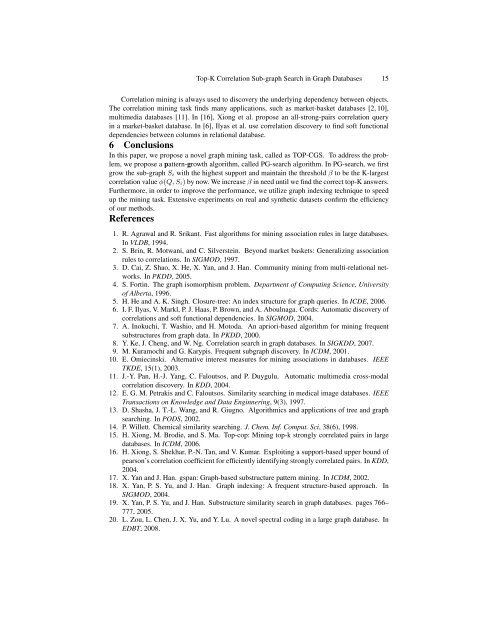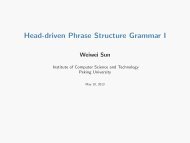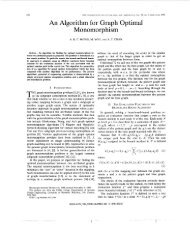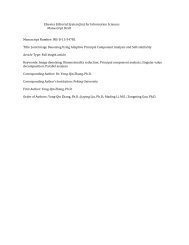Top-K Correlation Sub-graph Search in Graph Databases
Top-K Correlation Sub-graph Search in Graph Databases
Top-K Correlation Sub-graph Search in Graph Databases
Create successful ePaper yourself
Turn your PDF publications into a flip-book with our unique Google optimized e-Paper software.
<strong>Top</strong>-K <strong>Correlation</strong> <strong>Sub</strong>-<strong>graph</strong> <strong>Search</strong> <strong>in</strong> <strong>Graph</strong> <strong>Databases</strong> 15<strong>Correlation</strong> m<strong>in</strong><strong>in</strong>g is always used to discovery the underly<strong>in</strong>g dependency between objects.The correlation m<strong>in</strong><strong>in</strong>g task f<strong>in</strong>ds many applications, such as market-basket databases [2, 10],multimedia databases [11]. In [16], Xiong et al. propose an all-strong-pairs correlation query<strong>in</strong> a market-basket database. In [6], Ilyas et al. use correlation discovery to f<strong>in</strong>d soft functionaldependencies between columns <strong>in</strong> relational database.6 ConclusionsIn this paper, we propose a novel <strong>graph</strong> m<strong>in</strong><strong>in</strong>g task, called as TOP-CGS. To address the problem,we propose a pattern-growth algorithm, called PG-search algorithm. In PG-search, we firstgrow the sub-<strong>graph</strong> S i with the highest support and ma<strong>in</strong>ta<strong>in</strong> the threshold β to be the K-largestcorrelation value φ(Q, S i) by now. We <strong>in</strong>crease β <strong>in</strong> need until we f<strong>in</strong>d the correct top-K answers.Furthermore, <strong>in</strong> order to improve the performance, we utilize <strong>graph</strong> <strong>in</strong>dex<strong>in</strong>g technique to speedup the m<strong>in</strong><strong>in</strong>g task. Extensive experiments on real and synthetic datasets confirm the efficiencyof our methods.References1. R. Agrawal and R. Srikant. Fast algorithms for m<strong>in</strong><strong>in</strong>g association rules <strong>in</strong> large databases.In VLDB, 1994.2. S. Br<strong>in</strong>, R. Motwani, and C. Silverste<strong>in</strong>. Beyond market baskets: Generaliz<strong>in</strong>g associationrules to correlations. In SIGMOD, 1997.3. D. Cai, Z. Shao, X. He, X. Yan, and J. Han. Community m<strong>in</strong><strong>in</strong>g from multi-relational networks.In PKDD, 2005.4. S. Fort<strong>in</strong>. The <strong>graph</strong> isomorphism problem. Department of Comput<strong>in</strong>g Science, Universityof Alberta, 1996.5. H. He and A. K. S<strong>in</strong>gh. Closure-tree: An <strong>in</strong>dex structure for <strong>graph</strong> queries. In ICDE, 2006.6. I. F. Ilyas, V. Markl, P. J. Haas, P. Brown, and A. Aboulnaga. Cords: Automatic discovery ofcorrelations and soft functional dependencies. In SIGMOD, 2004.7. A. Inokuchi, T. Washio, and H. Motoda. An apriori-based algorithm for m<strong>in</strong><strong>in</strong>g frequentsubstructures from <strong>graph</strong> data. In PKDD, 2000.8. Y. Ke, J. Cheng, and W. Ng. <strong>Correlation</strong> search <strong>in</strong> <strong>graph</strong> databases. In SIGKDD, 2007.9. M. Kuramochi and G. Karypis. Frequent sub<strong>graph</strong> discovery. In ICDM, 2001.10. E. Omiec<strong>in</strong>ski. Alternative <strong>in</strong>terest measures for m<strong>in</strong><strong>in</strong>g associations <strong>in</strong> databases. IEEETKDE, 15(1), 2003.11. J.-Y. Pan, H.-J. Yang, C. Faloutsos, and P. Duygulu. Automatic multimedia cross-modalcorrelation discovery. In KDD, 2004.12. E. G. M. Petrakis and C. Faloutsos. Similarity search<strong>in</strong>g <strong>in</strong> medical image databases. IEEETransactions on Knowledge and Data Eng<strong>in</strong>ner<strong>in</strong>g, 9(3), 1997.13. D. Shasha, J. T.-L. Wang, and R. Giugno. Algorithmics and applications of tree and <strong>graph</strong>search<strong>in</strong>g. In PODS, 2002.14. P. Willett. Chemical similarity search<strong>in</strong>g. J. Chem. Inf. Comput. Sci, 38(6), 1998.15. H. Xiong, M. Brodie, and S. Ma. <strong>Top</strong>-cop: M<strong>in</strong><strong>in</strong>g top-k strongly correlated pairs <strong>in</strong> largedatabases. In ICDM, 2006.16. H. Xiong, S. Shekhar, P.-N. Tan, and V. Kumar. Exploit<strong>in</strong>g a support-based upper bound ofpearson’s correlation coefficient for efficiently identify<strong>in</strong>g strongly correlated pairs. In KDD,2004.17. X. Yan and J. Han. gspan: <strong>Graph</strong>-based substructure pattern m<strong>in</strong><strong>in</strong>g. In ICDM, 2002.18. X. Yan, P. S. Yu, and J. Han. <strong>Graph</strong> <strong>in</strong>dex<strong>in</strong>g: A frequent structure-based approach. InSIGMOD, 2004.19. X. Yan, P. S. Yu, and J. Han. <strong>Sub</strong>structure similarity search <strong>in</strong> <strong>graph</strong> databases. pages 766–777, 2005.20. L. Zou, L. Chen, J. X. Yu, and Y. Lu. A novel spectral cod<strong>in</strong>g <strong>in</strong> a large <strong>graph</strong> database. InEDBT, 2008.












